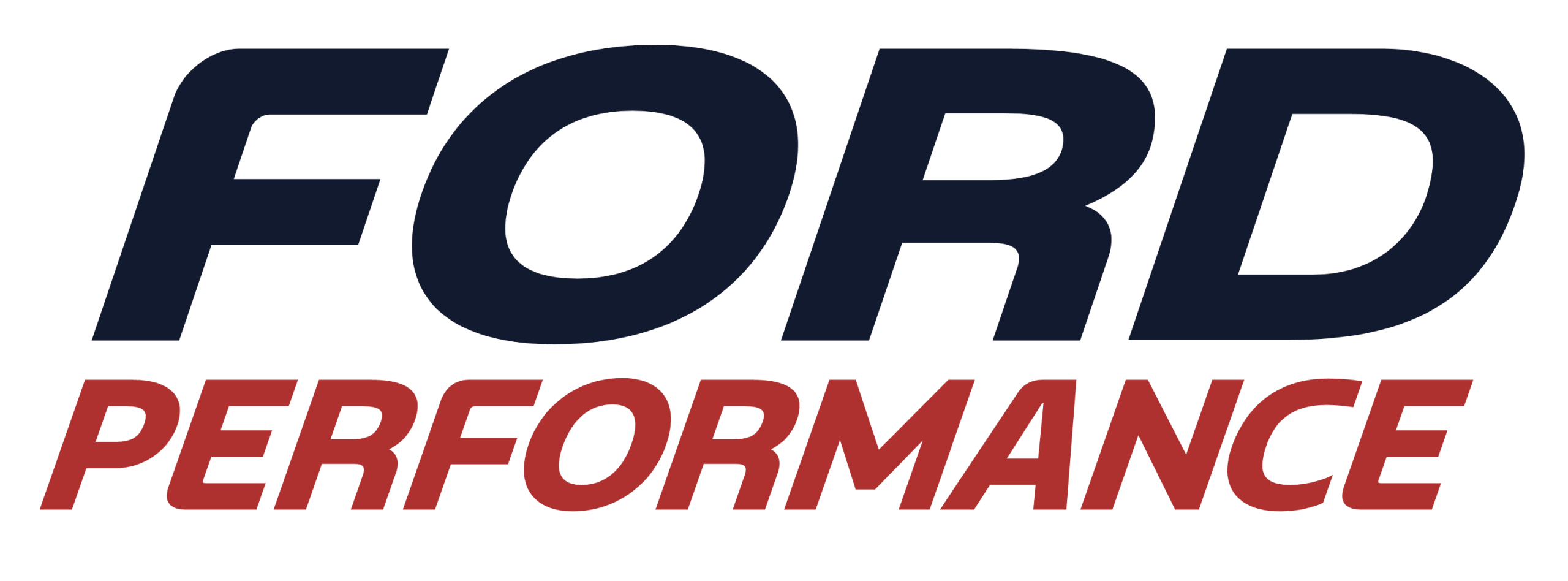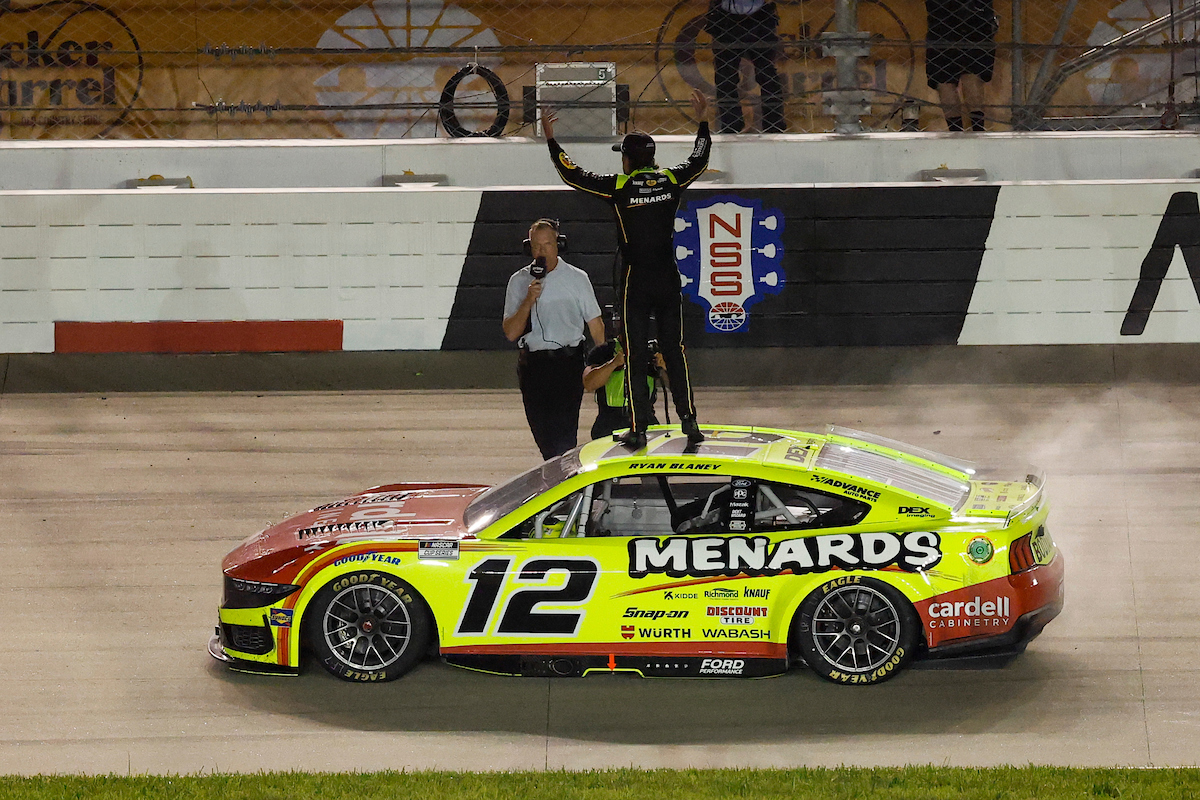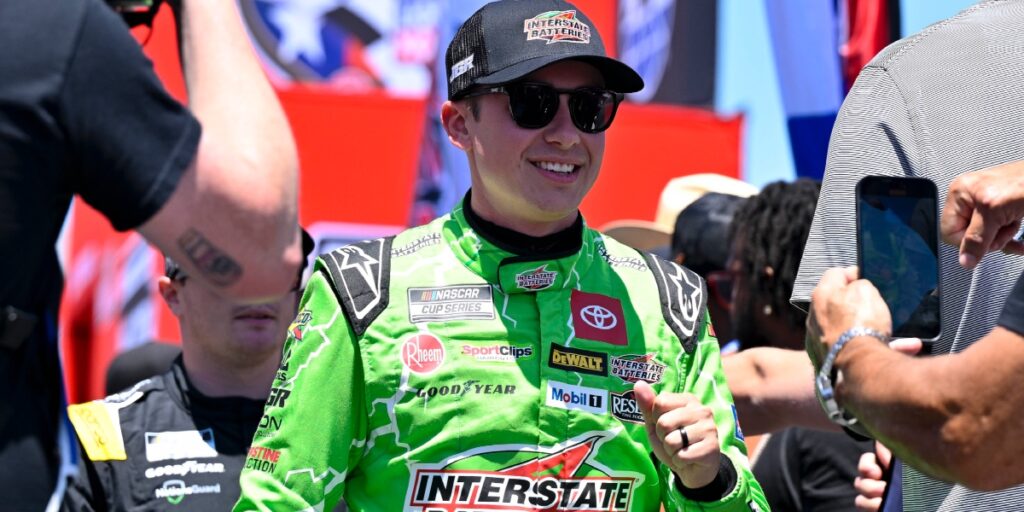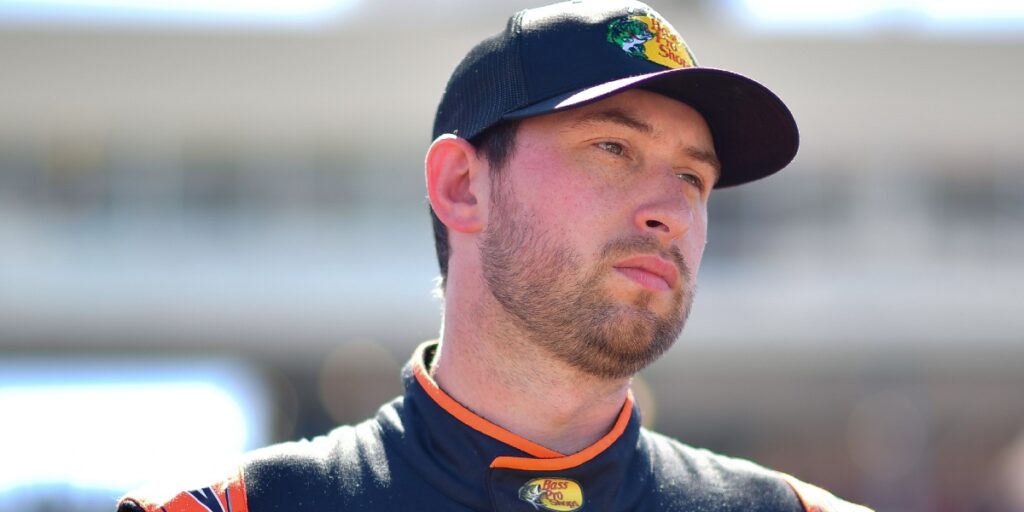LEBANON, Tenn. — Well, thank goodness that’s over.
One of the most tiresome storylines of this season had focused on Ryan Blaney’s lack of a victory, even though he had been outperforming his three teammates, who each had already won a race.
Anyone paying attention to NASCAR every week could tell Blaney has had one of the fastest cars all season, and only a series of unfortunate circumstances or mistakes have kept him from victory lane.
According to Grant Peters of Auto Racing Analytics, who supplied data at The Athletic’s request, Blaney was leading the series in both passing efficiency and defense heading into Nashville. Statistically, Peters said, Blaney completes an average pass on an intermediate track like Nashville in less than three laps of catching a car ahead of him — and he is also able to hold back a car in range for more than 14 laps on average.
Those are elite stats, so it should be no surprise that Blaney is a winner again. The only surprise is that it took him this long to have a race where nothing went wrong.
“Everything went smoothly, went like a normal race should go, and we executed like we should, and the speed in our car was good,” Blaney said. “It feels like those races for our team are hard to come by, just nothing funky happening. It’s nice it finally went that way tonight. The fastest car won the race and nothing wacky happened.”
Blaney isn’t just back in the playoffs, he’s a bona fide championship contender. He represents Team Penske’s best threat to reach the Championship 4 again, which will be held at Phoenix Raceway — the site of three consecutive titles for Penske drivers (including one for Blaney).
Don’t mistake Blaney for being the one-win-a-year guy of old, when he never seemed to reach the potential he showed in his early years. This Blaney is a much more well-rounded, savvy racer who appears to be an annual season-long threat; races like Nashville will continue to happen more often than not.
Hocevar rising
Another week, another brilliant flash of speed from Carson Hocevar — and another instance of him making enemies on the track.
Hocevar angered Ricky Stenhouse Jr. with an aggressive move to fill a hole and gain position; Stenhouse didn’t realize the second-year driver was going to jam the car into that spot, came down the track and Hocevar didn’t lift in time before they collided.
“I felt like I was there enough to get a call ‘inside’ (from the spotter) and have him just kind of run the middle,” Hocevar said. “Honestly, he probably could have cleared me. That’s what I expected him to do, and he didn’t. And by the time I checked up, I almost spun, too.”
Reached by text message, Stenhouse said their incident wasn’t the first of the night; in his view, there was a near miss two laps earlier when Hocevar had another huge run without care for whether Stenhouse was there or not. Stenhouse viewed it as Hocevar shooting for a hole and praying it’s going to be there without knowing the consequences.
Said Hocevar: “Yes, but at the same time, I feel like maybe I could have caught a break too, with how big of a run I had. So I think it goes both ways.”
But as part of the typical Carson Hocevar Experience, the Spire Motorsports driver was also blazing fast. He tied his career-best finish with a second-place result and moved five spots to 17th in the standings, now on the cusp of the playoff picture.
And yet he was downtrodden and disappointed to miss out on the win, despite Blaney clearly having more speed.
“My dream and expectation is to be here and win races and be up front,” Hocevar said. “It sucks when you don’t. If I wasn’t disappointed, I don’t deserve this seat. When I was a fan, I’d hate when people were pumped about second or third. I said I’d never be like that, and I feel like I’m not.”

Carson Hocevar tied his best-ever Cup Series finish with a second-place run Sunday at Nashville Superspeedway. (Sean Gardner / Getty Images)
More horsepower
Drivers’ ears perked up when NASCAR competition chief Elton Sawyer publicly broached the topic of increased horsepower last week — the No. 1 request on drivers’ wish lists for the entirety of the Next Gen Era.
“That’s the first time they’ve ever come out and said, ‘I think we can do it,’” Blaney said. “It’s definitely something all the drivers and teams want, and everyone watching wants it. They were only talking about doing it on short tracks and road courses, but if you’re going to do it at certain tracks, why not do it everywhere?”
But the conversation itself has some pitfalls. A horsepower increase will not be a magic cure for everything that ails the Next Gen on short tracks and road courses, which is why Christopher Bell said it was important to frame the horsepower discussion in a certain way for fans to “taper their expectations.”
The amount of horsepower being discussed is not a significant change, Bell said, but “directionally” better.
“Whenever we talk about wanting more horsepower, it stems from a place of wanting to be able to pass better,” Bell said. “Adding horsepower, no matter what the number is, is not going to make us pack race at a short track — but it should make passing easier.”
Josh Berry shared a similar concern: What if NASCAR increased the horsepower slightly and it didn’t materially change the quality of the racing?
“What I would hate to happen is to go up 100 horsepower and it doesn’t really look that different and everyone goes, ‘Oh, that wasn’t it,’” Berry said.
But in drivers’ minds, horsepower is it. At least a big part of solving the equation. So Denny Hamlin said even if the number was smaller than what drivers hoped, he would be happy just to take a minor win.
“Do I wish it was the big number we used to have? Absolutely,” Hamlin said. “But we need to be realistic, and even if it’s 80 to 100 (hp), we need to just take it and shut up and be thankful they’re willing to change.”
Larson’s regrets
Of the many things that Kyle Larson wishes he could do over again for his Double attempt last week, his sarcastic thumbs-up gesture to Scott McLaughlin is near the top of the list.
After a 45-minute rain delay at the Indy 500, the cars finally started rolling under the pace laps when McLaughlin, one of the pre-race favorites, suddenly lost control of his car and crashed while trying to warm up his tires. Larson spotter Tyler Monn radioed that someone up ahead had crashed (“f—ing idiot,” as Monn described it). An already-frustrated Larson, realizing the crash cleanup would only add to the time crunch he was in for the Double, then drove by and flashed a thumbs up in McLaughlin’s direction.
It was not a good look, and McLaughlin later responded on X with a quote-tweet that said: “Guess im out of the best driver in the world talks” with a shrug emoji. Larson texted McLaughlin during the week to apologize.
“As all of us, everybody in life, wishes they could go back and not do something or do something differently,” Larson said Saturday. “That’s one of those moments for me. I feel like I’m usually pretty good about not keying up or not doing gestures and stuff, but yeah, just let my frustration get the best of me there.
“It was a bit embarrassing, and I felt bad. You never want to see anybody crash out of the biggest race in the world before the green and (McLaughlin is) somebody who has always been super respectful to me and really nice to me. I didn’t even realize it was him until I was close to alongside of him. So just wish I could have taken that back.”
In Detroit for last weekend’s IndyCar race, McLaughlin told Fox Sports he knew Larson didn’t mean anything by the gesture.
“He’s really a respectful racer,” McLaughlin said. “And kudos to him for even reaching out. He didn’t need to. He doesn’t care about my IndyCar (race). I understand it. They know it’s logistically tough. … At the same time, Indy is Indy and the 600 is the 600, and if you want to run the risk of doing that, that’s up to you.”
Larson reiterated he is not currently interested in attempting the Double again due to the time crunch between the two races, which doesn’t allow for enough buffer in case of weather or long cautions. He said he would like to do the Indy 500 in the future once he is done with full-time NASCAR driving.
Caruth also rising
After Rajah Caruth won his second career Truck Series race on Friday night, we asked him about the pressure of being chased down by a future “Sunday guy” in the form of Corey Heim.
The question was barely finished before Caruth interjected: “I’d like to think I’m a future Sunday guy.”
Caruth has never doubted he will be. He speaks about his future success in “when” terms instead of “if.” His confidence in his abilities is high and seemingly unwavering. But to be a future Sunday guy, Caruth is going to need to win a lot more races. He just went well over a year between victories (Las Vegas in March 2024) and was outside of the Truck Series playoff standings before clinching a berth with his Friday win.
In Caruth’s mind, though, he continues to drill down on the process and thus doesn’t let the results frazzle him or force him into mistakes, as is sometimes the case for young drivers eager to prove themselves.
“I just kept my faith up through the ups and downs of the season,” he said. “Really poured into the people around me and just focused on the things that are in my control.”
Caruth said he does everything with “intention” — whether it’s a sim session, practice session, workout, pit practice or even taking personal time for himself. That way, he said, “it doesn’t feel like the end of the world when you have that pressure and that opportunity there in front of you.”
There’s still plenty of time to climb the ladder for a driver who turns 23 next week. His unique path has taken him from racing online while growing up in Washington D.C. to contending in real-life NASCAR races.
But if he’s going to truly make it, moments like Friday have to be more than an annual tradition.
(Top photo of Ryan Blaney celebrating Sunday’s win: Sean Gardner / Getty Images)





 at the
at the 

















 COLLECTIVE COLLAPSE OF EPIC PROPORTIONS! | First Take
COLLECTIVE COLLAPSE OF EPIC PROPORTIONS! | First Take














































 (via @zackystrong.pt/TT)
(via @zackystrong.pt/TT)

